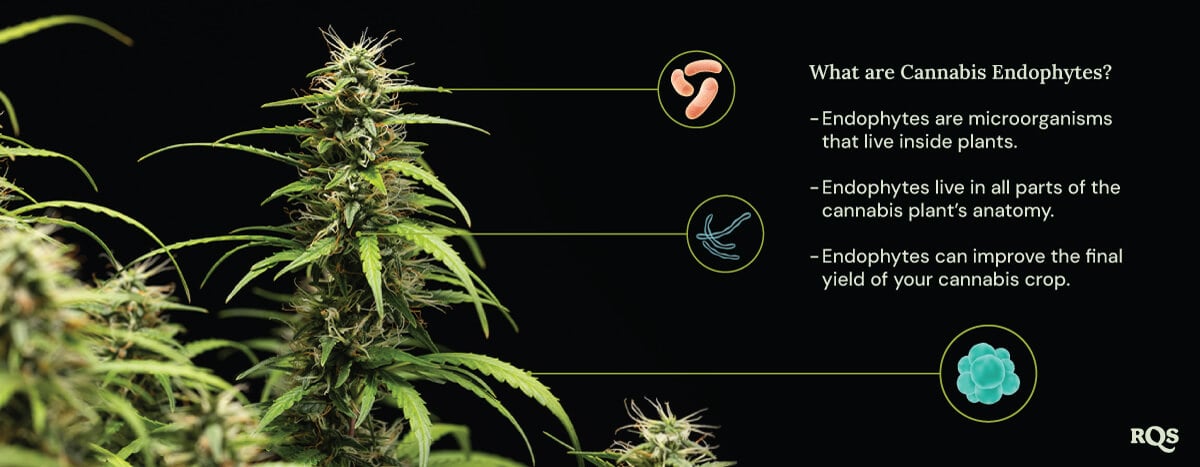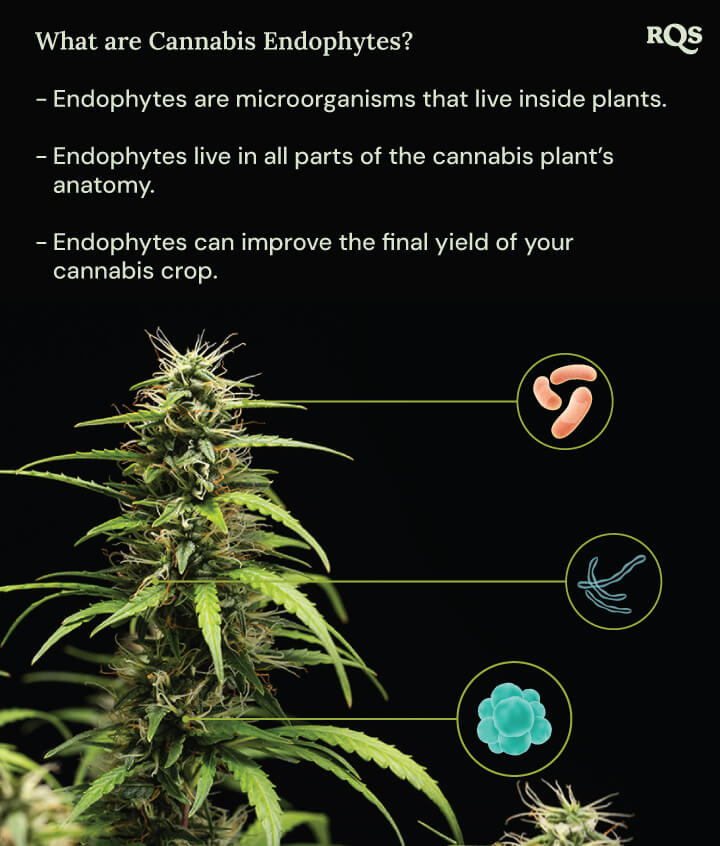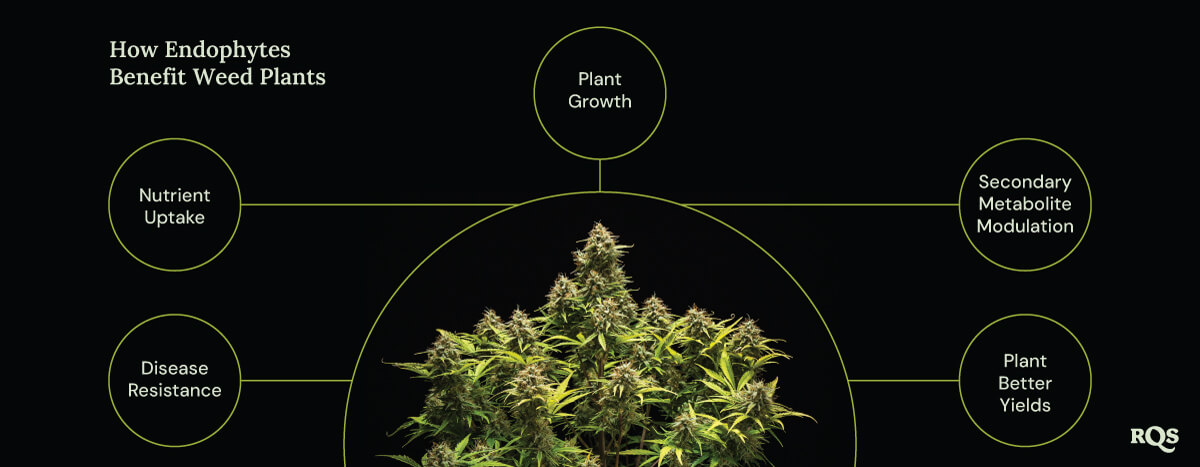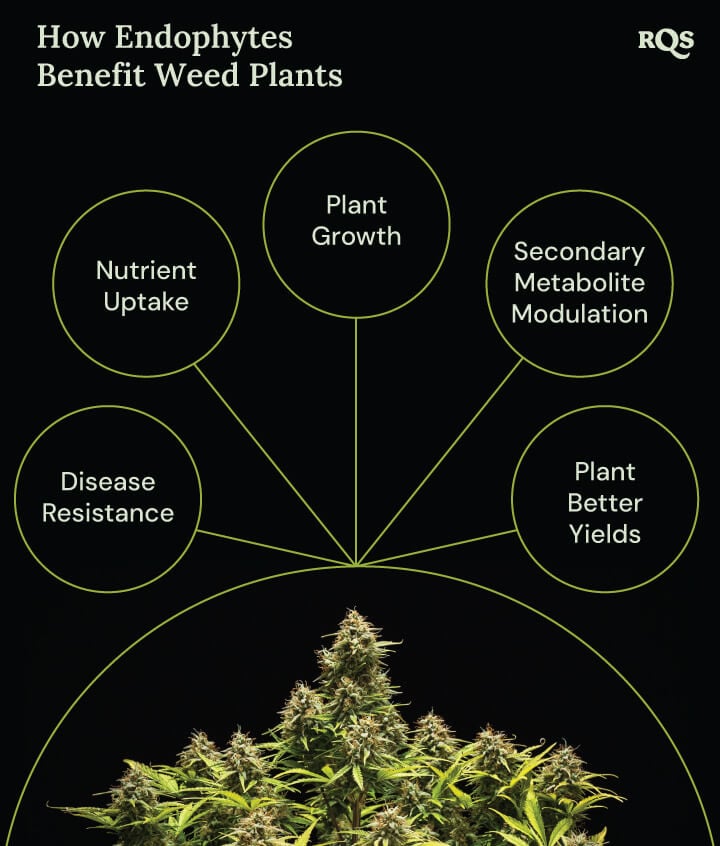.

Cannabis Endophytes: The Weed Plant's Microbiome
Endophytes are microorganisms that live inside plants. Here, we're looking at those that live within cannabis plants and asking how they might benefit their health and yields. Then, we'll explore how you can encourage the growth of these microbes in your own weed plants!
Contents:
Key points:
- Endophytes live in all parts of the cannabis plant’s anatomy.
- They form symbiotic, mutually beneficial relationships.
- Endophytes can improve the final yield of your cannabis crop.
- Organic farming methods promote endophyte growth.
Plants don’t just host an abundance of life on their surfaces, but within their bodies as well. Most of us are aware that animals have some kind of gut biome, but it’s not such common knowledge that plants have equivalent inner ecosystems too.
Here we’re investigating cannabis endophytes—the microorganisms that live inside cannabis plants.


An Introduction to the Holobiont Paradigm
For most of the period where “modern science” has reigned (and possibly preceding this), living organisms have been considered as distinct individuals. A person is a person, a bacterium is a bacterium, a plant is a plant, and so on. However, the holobiont paradigm challenges this notion. In relation to plants, it attempts to redefine them as interconnected communities of organisms, made up of the organisms that live on and within them, as well as those that live in the soil, with which they have a symbiotic relationship.
Ultimately, this paradigm views plants as part of a larger system that includes their associated microbiome.
-
The Microbiome and Plant Health
The microbiome of plants, and most larger organisms, includes bacteria, fungi, viruses, and other microorganisms. While most of us have been brought up to consider microorganisms as dirty pathogens, this is not the case. In fact, a diverse microbiome correlates with healthier, more resilient plants. Microbes help regulate nutrient cycles, defend against pathogens, and optimise environmental interactions.
Take soil for example. If soil is sterile, then there is nothing to stop an invasion of pathogens if one appears. If, on the other hand, there is a thriving soil biome, then it should hold itself in a state of equilibrium, meaning that though pathogens may be present, they cannot multiply unchecked.
What Are Cannabis Endophytes?
Endophytes are microorganisms that reside within plant tissues, either in a symbiotic, neutral, or occasionally parasitic relationship. They are organisms that can be considered distinct from the plant itself, but which nevertheless live within it and are dependent upon it.
Found in all plant species, endophytes are a key part of a plant’s internal ecosystem. Endophytes include all manner of species, and they form partnerships with plants in order to exchange nutrients and biochemical signals, often in a mutually beneficial way.
And a little bit of etymology: “endo” means “within” and “phyte” refers to the plant. So endophyte means something like “within the plant”.
-
How Do Endophytes Get Inside Cannabis Plants?
Depending on the species, endophytes have many methods of finding their way inside cannabis plants. This means that they are present throughout all stages of a plant’s life.
Key transmission methods include:
- Vertical transmission: Some endophytes are passed from parent plants via seeds and pollen. This ensures new generations inherit beneficial microbes.
- Root colonisation: Endophytes also enter through the root system, interacting with soil and the rhizosphere.
- Aerial parts: Microbes can enter through leaves, stems, and flowers via microscopic openings.
A Look at Endophytes Found in Cannabis Plants
Cannabis plants play host to diverse endophytes in various tissues across their anatomy. Let’s take a look at where different endophytes reside, and which species might be found where.
-
Buds
The buds are host to a range of different microorganisms—some of them beneficial. Microbial communities in buds may influence the plant’s chemical profile, including terpenes and cannabinoids. Species include:
| Pantoea sp. | Bacillus licheniformis | Bacillus sp. | Penicillium copticola |
| Pantoea sp. | Bacillus licheniformis | Bacillus sp. | Penicillium copticola |
-
Trichomes
Zooming in even more, not only do endophytes live within the buds of cannabis plants, but even with the trichomes growing on the buds. Nitrogen-fixing endophytes found in trichome cells are thought to contribute to nutrient cycles and may impact cannabinoid production.
-
Seeds
Seeds act as carriers of endophytes and are a key mode of transmission to later generations. Species present in cannabis seeds include:
| Brevibacterium sp. | Aureobasidium sp. | Cladosparium sp. |
| Brevibacterium sp. | Aureobasidium sp. | Cladosparium sp. |
-
Leaves
It’s possible that some of the endophytes found in leaves may enhance photosynthesis efficiency and may also help combat foliar diseases. Cannabis leaf endophytes include:
| Pseudomonas sp. | Cochliobolus sp. | Alternaria sp. |
| Pseudomonas sp. | Cochliobolus sp. | Alternaria sp. |
-
Petioles
Petioles are the small stalks that connect leaves to their branches. Microbes in petioles are thought to facilitate nutrient transport between leaves and stems, which is essential to plant vitality. Species living in the petiole biome include:
| Acinetobacter sp. | Agrobacterium sp. | Enterococcus sp. |
| Acinetobacter sp. | Agrobacterium sp. | Enterococcus sp. |
-
Stems
Stems contain endophytes that help to strengthen their structural integrity and also provide some protection against a range of pathogens. Stem endophytes include:
| Alternaria sp. | Schizophyllum sp. | Aspergillus flavus |
| Alternaria sp. | Schizophyllum sp. | Aspergillus flavus |
-
Roots
The fact that roots have symbiotic relationships with microorganisms is better understood and more well-researched than many other aspects of the cannabis plant. Root-associated endophytes play a crucial role in the rhizophagy cycle, where plants extract nutrients from microbes in exchange for sugars produced by the plant. Root endophytes include:
| Proteobacteria | Chryseobacterium | Pseudomonas sp. |
| Proteobacteria | Chryseobacterium | Pseudomonas sp. |
How Endophytes Benefit Weed Plants
There are many ways that endophytes can benefit weed plants, and working in tandem these can lead to healthier, more potent, and higher-yielding plants. So it’s worth knowing about!
-
Plant Growth
Certain endophytes can encourage the production of plant growth hormones like auxins and cytokinins. This leads to root elongation and branching, which in turn improves nutrient absorption, leading to overall better growth.
-
Nutrient Uptake
Nutrient uptake is improved by endophytes that live in the roots, as previously mentioned. The microorganisms provide accessible forms of essential nutrients, such as nitrogen and phosphorus, to the plants, enhancing nutrient absorption. They also work symbiotically with the plant to recycle nutrients in the soil.
-
Disease Resistance
As mentioned, the presence of a diverse ecosystem creates a competitive environment, meaning that harmful pathogens struggle to reproduce in a way that would be detrimental to plant health. This reduces the risk of disease and infection. What’s more, some even produce antimicrobial compounds that protect the plant internally.
-
Secondary Metabolite Modulation
By influencing the biosynthesis of cannabinoids and terpenes, endophytes are able to affect a plant’s aroma, flavour, and potency. We’re a ways off understanding how to harness this in such a manner that we can deliberately modulate the flavour and effects of our crop, but even knowing it might be possible is exciting.
-
Better Yields
Once everything is taken into consideration, we have healthier, better-fed, and faster-growing plants. All of this ultimately leads to high yields of quality bud, which is what most of us are looking for.


How to Harness the Power of Endophytes When Growing Weed
So, given the potential of endophytes to improve both the growing experience and the final product, you might want to know how to boost their presence in your crop. Chiefly, allowing nature to take its course is best—but strangely, that can be difficult sometimes. Here are some key tips to consider.
-
Don’t Sterilise Your Seeds
First off, don’t sterilise your cannabis seeds. This will kill the beneficial microbes living on them and will mean that the initial vertical transmission is blocked. Preserving natural transmission from mother to seedling is an easy way to give your plants their initial endophyte dose.
-
Use Regenerative Practices
Regenerative farming practices cause an explosion of life within the local ecosystem, and this will inevitably lead to the presence of endophytes. Regenerative practices include no-till farming, mulching, and composting.
Cover crops also encourage soil health and provide a habitat for beneficial microbes, and can therefore help your cannabis plants.
-
Apply Endophytes Directly
You can also apply endophytes directly for quicker results. This can be helpful if you’re growing indoors, where you can produce the sort of natural environment most conducive to endophyte growth. Use microbial inoculants like lactic acid bacteria (LAB) and algae to introduce beneficial microbes directly to plants.
The Future of Endophytes in Cannabis Cultivation
Research into cannabis endophytes is still in its early stages, but the potential is enormous. And this isn’t just true for cannabis cultivation, but for all plant cultivation. Not only might we be smoking better weed in the future thanks to endophytes, but we may well be eating healthier food too!
But regarding cannabis, we may well be able to map certain microbiomes to certain strains so that we can bring the best out of certain genotypes, further enhancing their qualities. Or, we might be able to produce endophyte-based organic treatments for a range of pests and diseases in order to maintain healthy crops without causing undue damage to the environment. With enough will, the possibilities are vast.






































